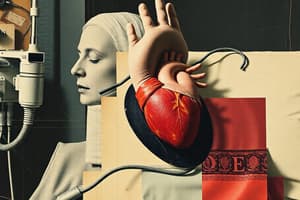Podcast
Questions and Answers
What is the primary purpose of venoarterial ECMO?
What is the primary purpose of venoarterial ECMO?
- It improves gas exchange in respiratory failure.
- It eliminates the need for protective ventilation.
- It is used for long-term cardiac support beyond weeks.
- It provides both gas exchange and hemodynamic support. (correct)
What complication can arise from retrograde blood flow in ECMO?
What complication can arise from retrograde blood flow in ECMO?
- Reduced risk of thrombosis.
- Increased left ventricular afterload. (correct)
- Decreased myocardial oxygen demand.
- Decreased cerebral perfusion.
In which situation is venovenous ECMO most commonly indicated?
In which situation is venovenous ECMO most commonly indicated?
- Cardiogenic shock.
- Acute hypercapnic respiratory failure. (correct)
- Pulmonary embolism.
- Sepsis due to systemic infection.
Which statement accurately describes the function of the VV ECMO circuit?
Which statement accurately describes the function of the VV ECMO circuit?
Which of the following is a characteristic of hybrid ECMO?
Which of the following is a characteristic of hybrid ECMO?
What is a critical consideration when weaning from VA ECMO?
What is a critical consideration when weaning from VA ECMO?
What is the primary purpose of an intra-aortic balloon pump (IABP)?
What is the primary purpose of an intra-aortic balloon pump (IABP)?
Which condition is a contraindication for the placement of an IABP?
Which condition is a contraindication for the placement of an IABP?
What is the maximum flow rate at which anticoagulation may not be needed during VV ECMO?
What is the maximum flow rate at which anticoagulation may not be needed during VV ECMO?
In which scenario would extracorporeal CPR be most appropriately used?
In which scenario would extracorporeal CPR be most appropriately used?
Flashcards are hidden until you start studying
Study Notes
Cardiac Assist Devices Overview
- ECMO (Extracorporeal Membrane Oxygenation) supports patients' respiratory and circulatory systems during extreme stress.
- Functions similarly to cardiopulmonary bypass (CPB).
- Two main types: Venovenous (VV) and Venoarterial (VA).
- Provides temporary support lasting from days to weeks.
Venovenous (VV) ECMO
- Primarily indicated for respiratory failure.
- Improves gas exchange and is used with protective ventilation.
- Catheter inserted into the internal jugular (IJ) with the tip in the inferior vena cava (IVC).
- Blood drains from the IVC and superior vena cava (SVC), goes through the oxygenator, and is reinfused towards the tricuspid valve.
- Double femoral cannula is an alternative configuration with drainage near the right atrium.
Venoarterial (VA) ECMO
- Offers gas exchange and hemodynamic support.
- Blood drains from a vein and is reinfused into an artery under pressure, enhancing blood flow.
- Utilized in cases of cardiogenic shock, inability to wean from CPB, allograft failure post-transplant, pulmonary embolism, sepsis, and peripartum cardiomyopathy.
Hybrid ECMO
- Combination of venoarterial and venovenous techniques.
- Maintains residual native cardiac function balancing deoxygenated blood into the ascending aorta, which can affect cerebral perfusion.
Complications Related to ECMO
- Retrograde blood flow increases left ventricular (LV) afterload and oxygen demand.
- Possible left ventricular venting solutions to redirect blood back to the ECMO circuit and reduce hypoxemia.
Management and Weaning from ECMO
- Use protective ventilation and anticoagulants.
- No set standards for anticoagulation; ACT typically maintained at 180-200 seconds before ECMO insertion.
- Hematological complications like HIT and von Willebrand disease can occur.
Intra-Aortic Balloon Pump (IABP)
- Common assist device installed via the femoral artery, often by interventional cardiologists.
- Balloon placed in the descending aorta; inflates during diastole to increase diastolic blood pressure and deflates during systole to reduce afterload.
Contraindications for IABP
- Aortic insufficiency (AI) as inflation can worsen valve function, leading to LV distention.
- Severe vascular disease, sepsis.
Ventricular Assist Devices (VADs)
- Types include left ventricular assist device (LVAD), right ventricular assist device (RVAD), and bi-ventricular assist device (BiVAD).
- LVAD draws blood from the left ventricle into a pump, sending it to the aorta; RVAD functions similarly for the right ventricle and pulmonary artery.
VAD Classification
- Classified based on duration (short or long-term) and type (continuous, pulsatile, axial).
- Used for bridging to transplant or as destination therapy; 2-year survival rate for destination therapy is 58%.
Continuous Flow VADs
- Benefits include smaller size, ease of implantation, reduced dissection and blood loss, and lower infection risk.
- Disadvantages include lack of valves leading to stasis and potential von Willebrand’s disease.
Intraoperative Considerations for VADs
- Standard monitoring, arterial lines, and TEE assessments are critical.
- Attention required for cerebral oxygenation and potential RV dysfunction.
Management in Non-Cardiac Surgery
- Understand device type, especially for continuous flow devices which are preload dependent.
- Anticoagulation switching from warfarin to heparin and preparation for blood component therapy is vital.
Complications Common to Cardiac Devices
- Concern for hemorrhage, thromboembolism, infections, device malfunctions, and vascular issues like limb ischemia or aortic dissection.
Studying That Suits You
Use AI to generate personalized quizzes and flashcards to suit your learning preferences.




